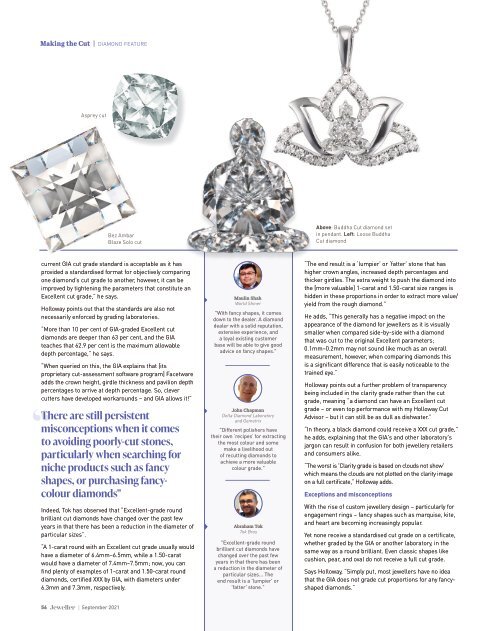Jeweller - September 2021
Create successful ePaper yourself
Turn your PDF publications into a flip-book with our unique Google optimized e-Paper software.
Making the Cut | DIAMOND FEATURE<br />
Asprey cut<br />
Bez Ambar<br />
Blaze Solo cut<br />
Above: Buddha Cut diamond set<br />
in pendant. Left: Loose Buddha<br />
Cut diamond<br />
current GIA cut grade standard is acceptable as it has<br />
provided a standardised format for objectively comparing<br />
one diamond’s cut grade to another, however, it can be<br />
improved by tightening the parameters that constitute an<br />
Excellent cut grade,” he says.<br />
Holloway points out that the standards are also not<br />
necessarily enforced by grading laboratories.<br />
“More than 10 per cent of GIA-graded Excellent cut<br />
diamonds are deeper than 63 per cent, and the GIA<br />
teaches that 62.9 per cent is the maximum allowable<br />
depth percentage,” he says.<br />
“When queried on this, the GIA explains that [its<br />
proprietary cut-assessment software program] Facetware<br />
adds the crown height, girdle thickness and pavilion depth<br />
percentages to arrive at depth percentage. So, clever<br />
cutters have developed workarounds – and GIA allows it!”<br />
There are still persistent<br />
misconceptions when it comes<br />
to avoiding poorly-cut stones,<br />
particularly when searching for<br />
niche products such as fancy<br />
shapes, or purchasing fancycolour<br />
diamonds"<br />
Indeed, Tok has observed that “Excellent-grade round<br />
brilliant cut diamonds have changed over the past few<br />
years in that there has been a reduction in the diameter of<br />
particular sizes”.<br />
“A 1-carat round with an Excellent cut grade usually would<br />
have a diameter of 6.4mm–6.5mm, while a 1.50-carat<br />
would have a diameter of 7.4mm–7.5mm; now, you can<br />
find plenty of examples of 1-carat and 1.50-carat round<br />
diamonds, certified XXX by GIA, with diameters under<br />
6.3mm and 7.3mm, respectively.<br />
Maulin Shah<br />
World Shiner<br />
"With fancy shapes, it comes<br />
down to the dealer. A diamond<br />
dealer with a solid reputation,<br />
extensive experience, and<br />
a loyal existing customer<br />
base will be able to give good<br />
advice on fancy shapes."<br />
John Chapman<br />
Delta Diamond Laboratory<br />
and Gemetrix<br />
"Different polishers have<br />
their own ‘recipes’ for extracting<br />
the most colour and some<br />
make a livelihood out<br />
of recutting diamonds to<br />
achieve a more valuable<br />
colour grade."<br />
Abraham Tok<br />
Tok Bros<br />
"Excellent-grade round<br />
brilliant cut diamonds have<br />
changed over the past few<br />
years in that there has been<br />
a reduction in the diameter of<br />
particular sizes... The<br />
end result is a 'lumpier' or<br />
'fatter' stone."<br />
“The end result is a ‘lumpier’ or ‘fatter’ stone that has<br />
higher crown angles, increased depth percentages and<br />
thicker girdles. The extra weight to push the diamond into<br />
the [more valuable] 1-carat and 1.50-carat size ranges is<br />
hidden in these proportions in order to extract more value/<br />
yield from the rough diamond.”<br />
He adds, “This generally has a negative impact on the<br />
appearance of the diamond for jewellers as it is visually<br />
smaller when compared side-by-side with a diamond<br />
that was cut to the original Excellent parameters;<br />
0.1mm–0.2mm may not sound like much as an overall<br />
measurement, however, when comparing diamonds this<br />
is a significant difference that is easily noticeable to the<br />
trained eye.”<br />
Holloway points out a further problem of transparency<br />
being included in the clarity grade rather than the cut<br />
grade, meaning “a diamond can have an Excellent cut<br />
grade – or even top performance with my Holloway Cut<br />
Advisor – but it can still be as dull as dishwater.”<br />
“In theory, a black diamond could receive a XXX cut grade,”<br />
he adds, explaining that the GIA's and other laboratory's<br />
jargon can result in confusion for both jewellery retailers<br />
and consumers alike.<br />
“The worst is 'Clarity grade is based on clouds not show'<br />
which means the clouds are not plotted on the clarity image<br />
on a full certificate,” Holloway adds.<br />
Exceptions and misconceptions<br />
With the rise of custom jewellery design – particularly for<br />
engagement rings – fancy shapes such as marquise, kite,<br />
and heart are becoming increasingly popular.<br />
Yet none receive a standardised cut grade on a certificate,<br />
whether graded by the GIA or another laboratory, in the<br />
same way as a round brilliant. Even classic shapes like<br />
cushion, pear, and oval do not receive a full cut grade.<br />
Says Holloway, “Simply put, most jewellers have no idea<br />
that the GIA does not grade cut proportions for any fancyshaped<br />
diamonds.”<br />
56 | <strong>September</strong> <strong>2021</strong>


















